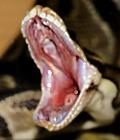» Site Navigation

0 members and 1,553 guests
No Members online
Most users ever online was 6,337, 01-24-2020 at 04:30 AM.
» Today's Birthdays

» Stats

Members: 75,178
Threads: 248,607
Posts: 2,569,170
Top Poster: JLC (31,651)
|
-
Registered User


 Originally Posted by Russ Lawson

Compare the shape of the head to the shape of the burmball. It still looks 100% burm to me. The pattern isn't anywhere near as soft as the hybrid's even if the arrow doesn't come to a point. Where P. molurus bivittatus typically has blushing on the head, the burmball has solid black. I'm not saying this might not change in the hybrid, but looking at that animal without taking into consideration its mutation, I completely fail to see where one would get the idea it might have ball python in it.
As far as some recessives being reproduced in F1 hybrids, I haven't heard of this personally before, but it seems to me the only likely case for that would be where the gene in one species doesn't line up with a gene in the other species (different size or number of chromosomes). My original thinking behind this was concerning hybrids of species with different total numbers of chromosomes, and due to this having a monoploidy of certain chromosomes in the hybrid. If the person who mentioned this has any more information on the subject, particularly if this was noticed in plants, I am very interested in hearing about it.
Anyway, because the members of the genus Python (and the other python genre for that matter) seem to have pretty good luck hybridizing, I find it most likely that they are extremely similar in their genetic makeup. Because of this, I think the chance of seeing any recessives reproduce in the first generation in them would be significantly low. Considering this, I wouldn't be surprised if the gene this mutation is on is very similar to the gene the piebald mutation is on in P. regius in terms of function as well as sequence. However, my vote is still on this particular animal being 100% burm.
I just heard that a recessive trait could show up in the first generation if there wasn't already an allele there for that chromosome. Sounds like laymans terms of what you said.
Has there been any consideration that this could be a piebald Indian python?
I'll push American, before I'll drive foreign.
Don't argue with an idiot, they'll drag you down to their level, then beat you with experience.
-
-
Re: Why aren't there a lot of burmese python morphs?
[QUOTE=Russ Lawson;1437894]Compare the shape of the head to the shape of the burmball. It still looks 100% burm to me. The pattern isn't anywhere near as soft as the hybrid's even if the arrow doesn't come to a point. Where P. molurus bivittatus typically has blushing on the head, the burmball has solid black. I'm not saying this might not change in the hybrid, but looking at that animal without taking into consideration its mutation, I completely fail to see where one would get the idea it might have ball python in it.[QUOTE]
That just being we have no idea what the head pattern would look like if the snakes were crossed with the pied gene. Im not saying its not a burm and I understand where your coming from. I just find it strange that noone knows any background information including the owner of the animal. And the head continues to throw me off. Even with most burm morphs we have today show strong arrowheads on the top of heads.
-
-
Registered User

Re: Why aren't there a lot of burmese python morphs?
 Originally Posted by Gibber19

holy smokes. @_@
-
 Posting Permissions
Posting Permissions
- You may not post new threads
- You may not post replies
- You may not post attachments
- You may not edit your posts
-
Forum Rules
|